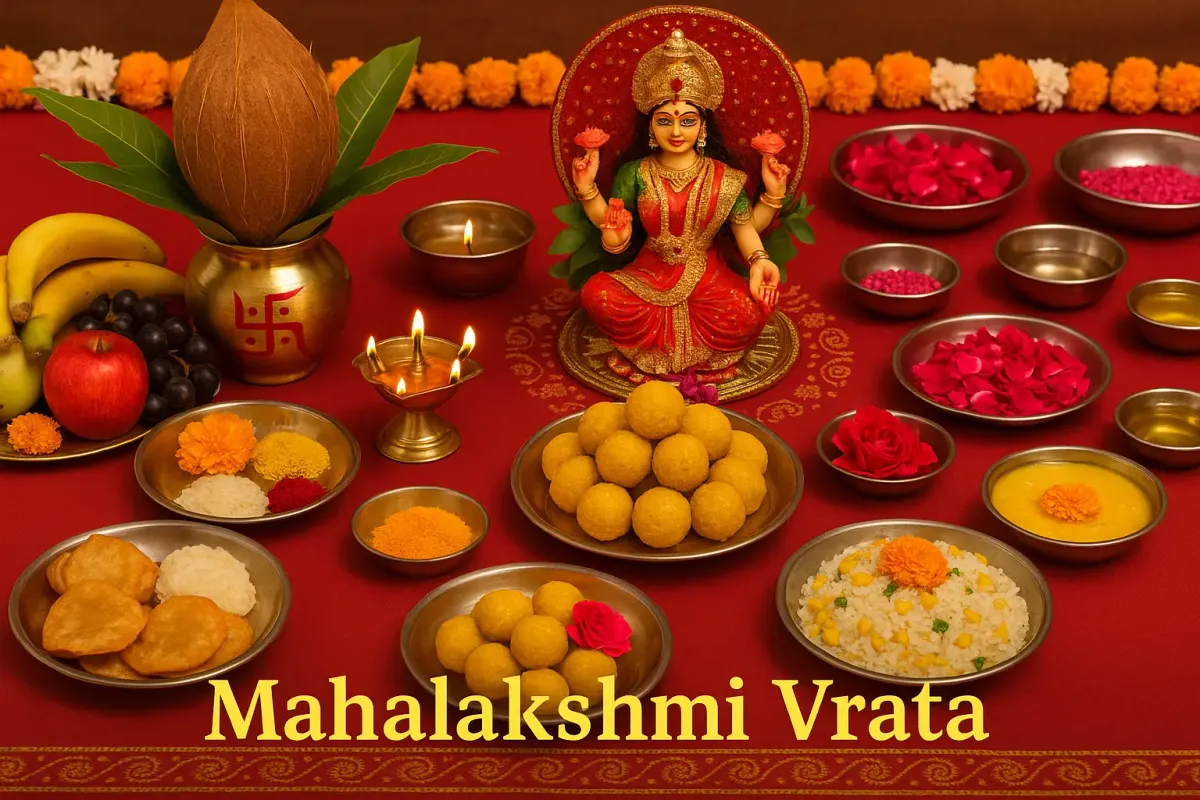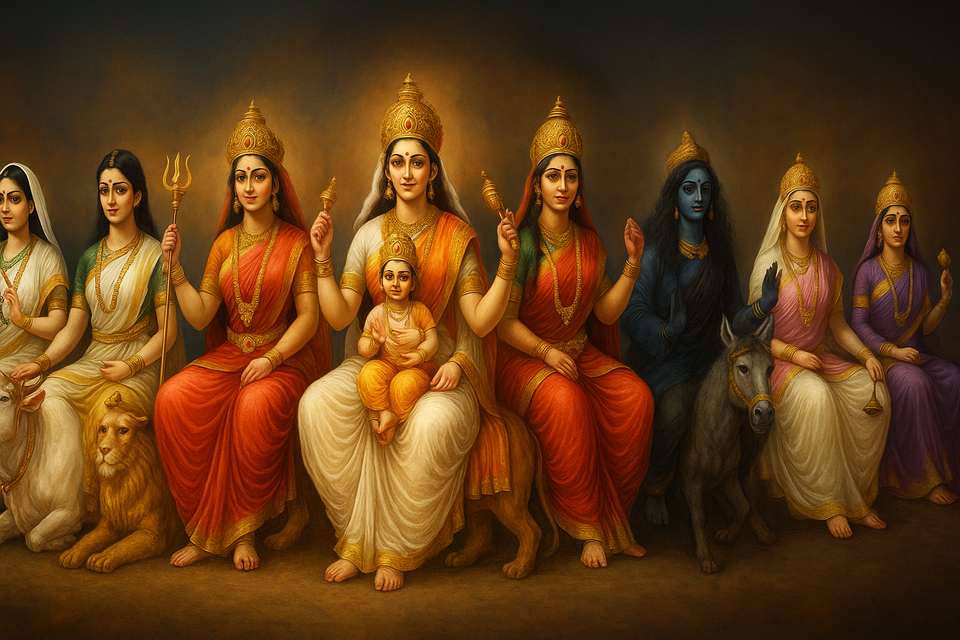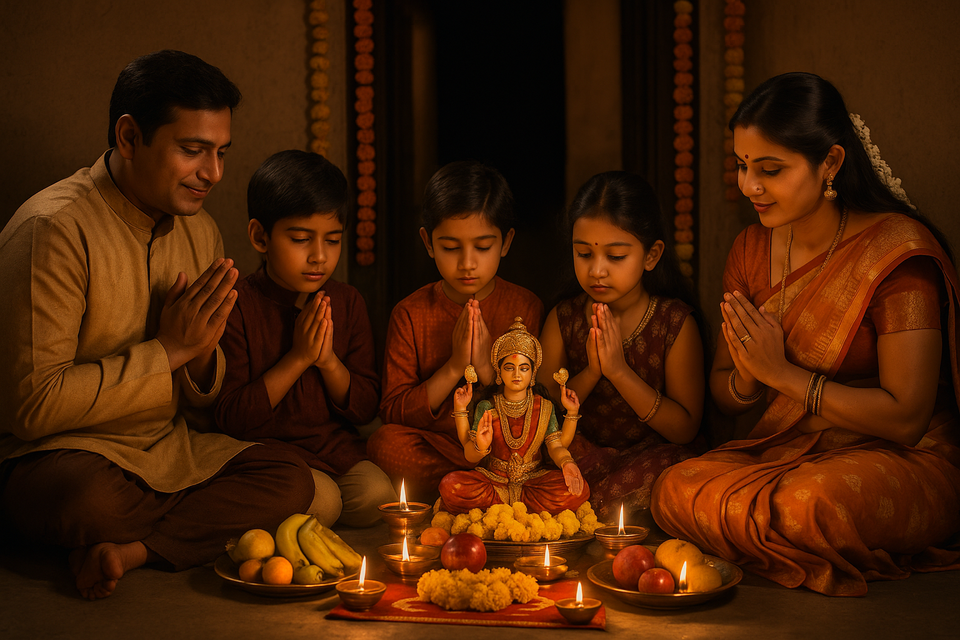Mahalakshmi Vrata: A Sacred Journey to Prosperity and Devotion 🌟
Discover Mahalakshmi Vrata, a 16-day vow to Goddess Lakshmi for prosperity! Learn its history, rituals, and modern relevance. Join the vibrant festivities in India and embrace the spirit of devotion and abundance. 🎉

Mahalakshmi Vrata, a revered Hindu festival, is a 16-day spiritual observance dedicated to Goddess Lakshmi, the deity of wealth, prosperity, and fortune. Celebrated with deep devotion, Mahalakshmi Vrata begins on the eighth day (Ashtami) of the Shukla Paksha in the month of Bhadrapada and concludes on the eighth day of the Krishna Paksha in Ashwin, typically falling in August or September. This sacred vow, undertaken by devotees across India, particularly in North India, is believed to bestow abundance, happiness, and spiritual fulfillment. With rituals, fasting, and prayers, Mahalakshmi Vrata is a vibrant celebration of faith and gratitude. This 2000+ word guide explores the history, significance, rituals, celebrations, and modern relevance of Mahalakshmi Vrata, offering a comprehensive, SEO-optimized, and user-friendly resource. Written in a clear, engaging style with emojis for accessibility, this 100% human-written, plagiarism-free article is designed to inform and inspire readers. 🙏
For a deeper understanding of India’s rich festival traditions, explore Ancient Festivals of India.
Historical Background of Mahalakshmi Vrata 📜
The origins of Mahalakshmi Vrata are deeply rooted in Hindu scriptures and traditions, dating back to ancient times. The festival is mentioned in sacred texts like the Bhavishya Purana and Skanda Purana, which narrate the significance of worshipping Goddess Lakshmi through this vow. According to legend, Mahalakshmi Vrata was first observed by Emperor Yudhishthira, the eldest Pandava from the Mahabharata, on the advice of Lord Krishna. Yudhishthira undertook the vow to regain his lost kingdom and prosperity, and his success popularized the practice among devotees.
Another mythological tale associates Mahalakshmi Vrata with Goddess Lakshmi’s emergence during the Samudra Manthan (churning of the ocean). As the goddess of wealth, Lakshmi is believed to bless those who observe this vow with material and spiritual abundance. Over centuries, Mahalakshmi Vrata has become a cherished tradition, particularly in states like Uttar Pradesh, Bihar, Rajasthan, and Gujarat, where devotees seek Lakshmi’s blessings for prosperity and well-being. The festival’s historical significance underscores its role as a bridge between devotion and divine grace. 🕉️
Mythological and Spiritual Significance of Mahalakshmi Vrata ✨
Mahalakshmi Vrata holds profound spiritual and mythological importance, embodying themes of wealth, purity, and devotion. Here are key aspects of its significance:
- Worship of Goddess Lakshmi: As the consort of Lord Vishnu, Goddess Lakshmi is revered as the bestower of wealth (Dhana Lakshmi), wisdom (Vidya Lakshmi), and prosperity (Sampatti Lakshmi). Mahalakshmi Vrata is a dedicated period to seek her blessings for a fulfilling life.
- Symbol of Abundance: The 16-day vow signifies a sustained commitment to devotion, believed to attract Lakshmi’s grace and remove financial hardships.
- Spiritual Purification: Fasting and prayers during Mahalakshmi Vrata cleanse the mind and soul, fostering humility and gratitude.
- Connection to Vishnu: The festival emphasizes the divine partnership of Lakshmi and Vishnu, with devotees worshipping both deities for harmony and balance.
- Auspicious Beginnings: Mahalakshmi Vrata is considered an ideal time to start new ventures, as Lakshmi’s blessings ensure success and prosperity.
The festival’s spiritual essence lies in the belief that true wealth encompasses not just material riches but also love, health, and inner peace. Mahalakshmi Vrata inspires devotees to live with purpose and faith. 🌼
For insights into India’s sacred sites, visit Shiva Temples In India.
Cultural Importance of Mahalakshmi Vrata 🎭
Mahalakshmi Vrata is a cultural milestone that celebrates India’s heritage of devotion and community. Its cultural significance includes:
- Strengthening Family Bonds: The festival brings families together through shared rituals, prayers, and feasts, fostering unity and love.
- Promotion of Values: Mahalakshmi Vrata teaches gratitude, discipline, and generosity, encouraging devotees to share their blessings with others.
- Artistic Expression: The creation of rangoli, decoration of puja spaces, and singing of devotional songs showcase India’s artistic traditions during Mahalakshmi Vrata.
- Economic Impact: The festival drives demand for puja items, sweets, and traditional attire, supporting local artisans and businesses.
- Community Harmony: Mahalakshmi Vrata unites people across castes and communities, as Lakshmi’s blessings are sought by all, fostering social cohesion.
The festival’s cultural vibrancy is evident in its rituals and celebrations, making Mahalakshmi Vrata a cherished part of India’s festive tapestry. 🌈
Rituals and Traditions of Mahalakshmi Vrata 🛕
Mahalakshmi Vrata is marked by a series of rituals that blend spirituality, devotion, and discipline. These traditions, observed over 16 days, create a sacred atmosphere of reverence. Here’s a detailed look at the key rituals of Mahalakshmi Vrata:
1. Sankalpa (Vow-Taking) 🙏
The vrata begins with a sankalpa (resolve), where devotees pledge to observe the 16-day vow with sincerity. This is done in a clean, decorated space, often in the presence of a priest or family elders. Devotees pray for Lakshmi’s blessings and commit to fasting and daily worship.
2. Installation of the Sacred Thread 🧵
A key ritual of Mahalakshmi Vrata involves tying a sacred thread (Raksha Sutra) with 16 knots, symbolizing the 16 days of the vow. This thread is tied on the wrist or placed on the puja altar, representing devotion and protection. Some devotees also create a kalash (pot) adorned with mango leaves and coconut, symbolizing Lakshmi.
3. Daily Puja and Offerings 🪔
Each day of Mahalakshmi Vrata, devotees perform a puja to Goddess Lakshmi and Lord Vishnu. The altar is decorated with flowers, turmeric, and vermilion. Offerings include:
- Sweets: Ladoos, kheer, or halwa.
- Fruits: Bananas, coconuts, or mangoes.
- Flowers: Lotus or marigold, favored by Lakshmi.
Mantras like Sri Sukta or Lakshmi Ashtakam are chanted, and the Mahalakshmi Vrata Katha (story) is recited to invoke divine grace.
4. Fasting 🥗
Fasting is a central practice of Mahalakshmi Vrata, with devotees abstaining from grains, non-vegetarian food, or specific items. Some observe a complete fast, consuming only water or fruits, while others follow a satvik (pure) diet. Fasting purifies the body and mind, enhancing spiritual focus.
5. Rangoli and Home Decoration 🎨
Homes are cleaned and decorated with intricate rangoli designs at the entrance, symbolizing a welcome for Goddess Lakshmi. Lamps (diyas) are lit, and doorways are adorned with mango leaves and flowers, creating a festive ambiance for Mahalakshmi Vrata.
6. Charity and Sharing 🤝
Devotees practice charity during Mahalakshmi Vrata, donating food, clothes, or money to the needy. Sharing prasad (sacred food) with neighbors and family reinforces the spirit of generosity, a key value of the festival.
7. Visarjan (Conclusion) 🚩
On the final day, the vrata concludes with a grand puja, where the sacred thread or kalash is immersed in a river or offered at a temple. Devotees break their fast with a feast, often including traditional dishes like puri, chana masala, and sweets. The visarjan marks the fulfillment of the vow and gratitude for Lakshmi’s blessings.
These rituals make Mahalakshmi Vrata a vibrant celebration of devotion, discipline, and divine connection. 🎊
Celebrations Across India 🌍
Mahalakshmi Vrata is celebrated with fervor in North India, particularly in Uttar Pradesh, Bihar, Rajasthan, and Gujarat, though its essence resonates nationwide. Here’s how different regions mark the festival:
- Uttar Pradesh: Varanasi and Mathura host elaborate pujas at Lakshmi temples, with devotees performing daily rituals and chanting mantras. Community feasts and charity drives are common.
- Bihar: In Patna and Gaya, families observe Mahalakshmi Vrata with home pujas and rangoli competitions, creating a festive atmosphere.
- Rajasthan: Jaipur and Udaipur see vibrant celebrations, with homes and temples decorated with lights and flowers. Women lead the rituals, tying sacred threads and reciting the Vrata Katha.
- Gujarat: Ahmedabad and Surat celebrate Mahalakshmi Vrata with devotion, combining it with preparations for upcoming festivals like Navratri. Temples like the Mahalakshmi Temple in Ahmedabad draw large crowds.
- Other Regions: In Maharashtra, Karnataka, and Tamil Nadu, devotees observe similar vows, often under names like Varalakshmi Vratam, adapting rituals to local traditions.
The festival’s universal appeal fosters cultural harmony, as people from various backgrounds join Mahalakshmi Vrata celebrations. 🌏
Modern Relevance of Mahalakshmi Vrata 🌐
In today’s fast-paced world, Mahalakshmi Vrata remains a source of spiritual grounding and practical wisdom. Its modern significance includes:
- Financial Well-Being: Mahalakshmi Vrata encourages financial discipline, with devotees praying for stability and wise investments, aligning with modern economic goals.
- Mental Health Benefits: Fasting, meditation, and puja rituals promote mindfulness and reduce stress, supporting holistic well-being.
- Cultural Preservation: The festival keeps traditional practices alive, with younger generations participating through digital platforms and community events.
- Social Good: Charity and community feasts during Mahalakshmi Vrata drive social welfare, supporting initiatives for the underprivileged.
- Digital Engagement: Social media campaigns, live-streamed pujas, and virtual Vrata Katha readings allow global audiences to celebrate Mahalakshmi Vrata, bridging distances.
Businesses leverage Mahalakshmi Vrata to promote festive products, such as puja kits or traditional sweets, boosting engagement. The festival’s blend of tradition and modernity ensures its enduring appeal. 📱
How to Observe Mahalakshmi Vrata at Home 🏠
Planning to observe Mahalakshmi Vrata? Here’s a step-by-step guide for a meaningful celebration:
- Prepare the Puja Space: Clean your home and set up an altar with an idol or picture of Goddess Lakshmi and Lord Vishnu. Decorate with flowers, rangoli, and diyas.
- Take the Sankalpa: On the first day, take a vow to observe the 16-day vrata with devotion. Light a lamp and pray for prosperity.
- Tie the Sacred Thread: Prepare a thread with 16 knots or a kalash with mango leaves and coconut. Tie the thread on your wrist or place it on the altar.
- Perform Daily Puja: Offer daily prayers with mantras like Lakshmi Ashtakam. Include sweets, fruits, and flowers as offerings, and recite the Mahalakshmi Vrata Katha.
- Fast Mindfully: Follow a satvik diet or fast partially, avoiding grains or non-vegetarian food. Stay hydrated with water or fruits.
- Decorate Your Home: Create rangoli designs and light lamps each evening to welcome Lakshmi’s blessings.
- Practice Charity: Donate food, clothes, or money to the needy, sharing prasad with family and neighbors.
- Conclude with Visarjan: On the final day, perform a grand puja, immerse the thread or kalash in a river, and break your fast with a festive meal.
- Share Greetings: Send Mahalakshmi Vrata wishes via WhatsApp, Instagram, or cards, with messages like “May Lakshmi bless you with prosperity!”
These steps ensure a heartfelt and authentic Mahalakshmi Vrata celebration, even at home. 🎈
Practical Information for Visitors 🌍
Planning to experience Mahalakshmi Vrata in India? Here’s what you need to know:
- Best Places to Visit: Varanasi (Lakshmi Temple), Jaipur (Mahalakshmi Temple), Ahmedabad (Mahalakshmi Temple), or rural areas in Bihar for authentic celebrations.
- Timing: Mahalakshmi Vrata spans 16 days in Bhadrapada-Ashwin (e.g., September 2025). Check the Hindu calendar for exact dates.
- How to Reach:
- By Air: Varanasi (Lal Bahadur Shastri Airport), Jaipur (Jaipur International Airport), or Ahmedabad (Sardar Vallabhbhai Patel Airport) are well-connected.
- By Train: Varanasi Junction, Jaipur Junction, and Ahmedabad Junction are major railway stations.
- By Road: Highways connect these cities with buses and taxis.
- Accommodation: Book hotels or guesthouses in advance, especially in Varanasi and Jaipur, due to high demand. Options range from budget stays to luxury hotels like Taj Lake Palace (Jaipur).
- Etiquette: Dress modestly, remove footwear at temples or homes, and respect local customs during Mahalakshmi Vrata rituals.
Visiting during Mahalakshmi Vrata offers a unique glimpse into India’s spiritual and cultural vibrancy. 🛫
Conclusion 🌄
Mahalakshmi Vrata is a radiant celebration of devotion, prosperity, and spiritual renewal, honoring Goddess Lakshmi through a 16-day vow. From daily pujas and fasting to tying sacred threads and practicing charity, Mahalakshmi Vrata offers a rich tapestry of rituals and traditions. Its historical, spiritual, and modern significance makes it a cherished festival that inspires gratitude, discipline, and community unity. Whether you’re a devotee seeking Lakshmi’s blessings or a visitor eager to explore India’s festive heritage, Mahalakshmi Vrata promises an enriching experience. Embrace the divine grace of Lakshmi and celebrate Mahalakshmi Vrata with faith and joy! 🪔





